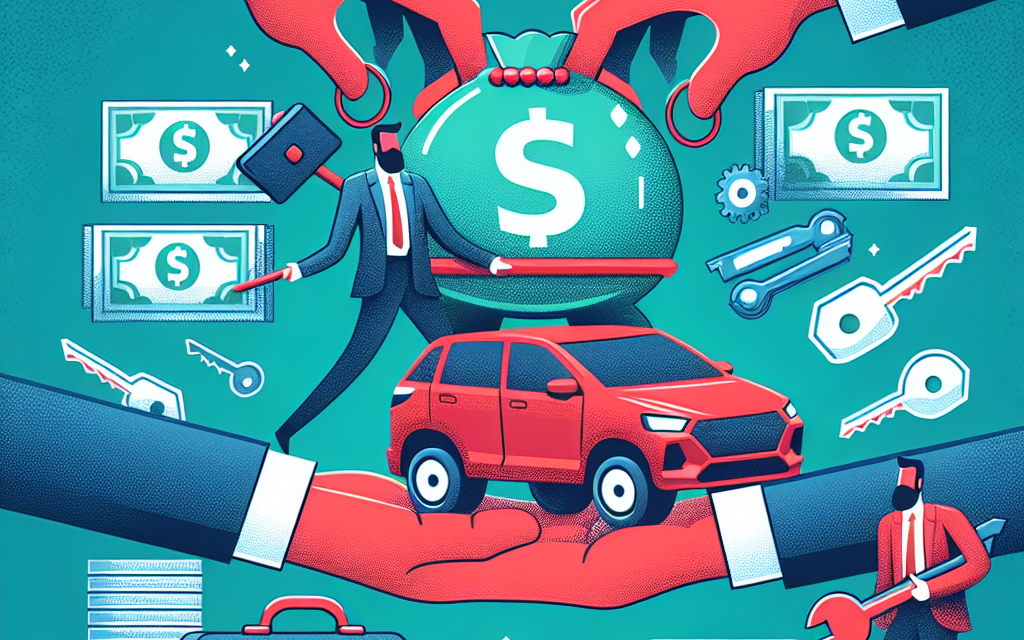“JPMorgan: Navigating Carvana’s Lending Landscape with Confidence.”
Introduction
JPMorgan recently addressed concerns surrounding Carvana’s lending practices, asserting that the apprehensions are overstated. The bank highlighted the company’s robust business model and its strategic initiatives aimed at enhancing operational efficiency and customer experience. By emphasizing Carvana’s adaptability in the evolving automotive market and its commitment to responsible lending, JPMorgan aims to reassure investors and stakeholders about the company’s long-term viability and growth potential.
Carvana’s Financial Health: Analyzing JPMorgan’s Perspective
In recent discussions surrounding Carvana’s financial health, JPMorgan has emerged as a prominent voice, asserting that concerns regarding the online used car retailer’s lending practices are overstated. This perspective is particularly significant given the broader context of the automotive industry, which has faced numerous challenges in recent years, including supply chain disruptions and fluctuating consumer demand. By examining JPMorgan’s analysis, one can gain a clearer understanding of Carvana’s position in the market and the implications for its future.
To begin with, it is essential to recognize that Carvana has experienced substantial growth since its inception, driven by a unique business model that emphasizes convenience and transparency in the car-buying process. This model has resonated with consumers, particularly in an era where digital transactions have become increasingly prevalent. As a result, Carvana has carved out a niche for itself, attracting a loyal customer base and expanding its market share. JPMorgan’s assessment highlights that this growth trajectory is not merely a fleeting trend but rather a reflection of a fundamental shift in consumer behavior.
Moreover, JPMorgan points to Carvana’s robust operational framework as a mitigating factor against the concerns surrounding its lending practices. The bank emphasizes that Carvana has implemented stringent underwriting standards and risk management protocols, which serve to safeguard its financial stability. By maintaining a disciplined approach to lending, Carvana is better positioned to navigate potential economic downturns and fluctuations in the automotive market. This perspective counters the narrative that Carvana is overly reliant on aggressive lending strategies, suggesting instead that the company is taking a measured approach to growth.
In addition to its operational strengths, JPMorgan also underscores the importance of Carvana’s diversified revenue streams. While the company’s core business revolves around vehicle sales, it has successfully expanded into ancillary services such as vehicle financing and warranties. This diversification not only enhances Carvana’s revenue potential but also provides a buffer against market volatility. By leveraging multiple income sources, Carvana can mitigate risks associated with any single segment of its business, thereby reinforcing its overall financial health.
Furthermore, it is crucial to consider the broader economic landscape when evaluating Carvana’s prospects. The automotive industry is undergoing a transformation, with increasing consumer interest in electric vehicles and a shift towards online purchasing. As these trends continue to evolve, Carvana is well-positioned to capitalize on the changing dynamics of the market. JPMorgan’s analysis suggests that the company’s innovative approach and adaptability will enable it to thrive in this new environment, further alleviating concerns about its lending practices.
In conclusion, while apprehensions regarding Carvana’s lending practices have garnered attention, JPMorgan’s perspective offers a more nuanced understanding of the company’s financial health. By highlighting Carvana’s growth trajectory, operational strengths, diversified revenue streams, and adaptability to market changes, JPMorgan presents a compelling case that the concerns surrounding the company are exaggerated. As Carvana continues to navigate the complexities of the automotive industry, it is essential for stakeholders to consider these factors in order to form a balanced view of the company’s future prospects. Ultimately, the narrative surrounding Carvana is one of resilience and opportunity, rather than one of impending financial distress.
The Impact of Lending Practices on Carvana’s Growth
JPMorgan has recently addressed concerns surrounding Carvana’s lending practices, suggesting that the apprehensions are overstated and do not accurately reflect the company’s potential for growth. As the online used car retailer continues to navigate a competitive landscape, understanding the implications of its lending strategies becomes crucial. Carvana’s innovative approach to vehicle sales, which includes a seamless online purchasing experience and a unique vehicle delivery model, has positioned it as a disruptive force in the automotive industry. However, the company’s reliance on external financing and its lending practices have raised eyebrows among investors and analysts alike.
To begin with, it is essential to recognize that Carvana’s business model is inherently tied to its ability to secure financing for its customers. The company has developed partnerships with various lenders to facilitate vehicle purchases, allowing customers to obtain loans quickly and efficiently. This streamlined process not only enhances the customer experience but also drives sales volume, which is vital for Carvana’s growth trajectory. While some critics argue that the company’s lending practices may expose it to higher default rates, JPMorgan contends that these concerns are largely unfounded. The bank emphasizes that Carvana’s underwriting standards and risk management strategies are robust, mitigating potential risks associated with lending.
Moreover, the broader economic context plays a significant role in shaping Carvana’s lending landscape. As interest rates fluctuate and the economy experiences cycles of growth and contraction, the demand for used vehicles often remains resilient. Carvana’s ability to adapt to changing market conditions is a testament to its operational agility. The company has demonstrated a keen understanding of consumer behavior, particularly during economic downturns when individuals may opt for used vehicles over new ones. This adaptability not only supports Carvana’s sales but also reinforces the stability of its lending practices.
In addition to these factors, it is important to consider the competitive advantages that Carvana possesses in the used car market. The company’s extensive inventory, coupled with its innovative technology, allows it to offer a diverse range of vehicles to consumers. This variety not only attracts a broad customer base but also enhances the likelihood of successful loan approvals. By providing customers with a wide selection of vehicles, Carvana increases the chances of securing financing, thereby alleviating some of the concerns surrounding its lending practices.
Furthermore, JPMorgan’s analysis highlights the potential for Carvana to expand its lending capabilities in the future. As the company continues to grow, it may explore opportunities to establish its own financing arm, which could further enhance its control over the lending process. This vertical integration would not only streamline operations but also allow Carvana to tailor its lending practices to better align with its customer base. Such a move could ultimately bolster investor confidence and mitigate concerns regarding the company’s current lending strategies.
In conclusion, while apprehensions regarding Carvana’s lending practices have surfaced, JPMorgan’s perspective suggests that these concerns are exaggerated. The company’s innovative business model, coupled with its adaptability to market conditions and competitive advantages, positions it favorably for continued growth. As Carvana navigates the complexities of the automotive industry, its ability to manage lending effectively will be a critical factor in determining its long-term success. By focusing on its strengths and addressing potential risks, Carvana can continue to thrive in an ever-evolving marketplace.
JPMorgan’s Role in Carvana’s Financing Strategies
JPMorgan Chase & Co. has played a pivotal role in shaping the financing strategies of Carvana, the online used car retailer that has garnered significant attention in recent years. As Carvana navigates the complexities of the automotive market, the involvement of a financial powerhouse like JPMorgan provides a layer of credibility and stability that is often overlooked. While concerns regarding Carvana’s lending practices have surfaced, it is essential to understand the broader context of these financial strategies and the implications they hold for the company’s future.
To begin with, JPMorgan’s extensive experience in the financial sector equips it with the tools necessary to assess and manage risk effectively. The bank’s involvement in Carvana’s financing is not merely a transactional relationship; it reflects a strategic partnership aimed at fostering growth and innovation within the used car market. By leveraging its vast resources and expertise, JPMorgan has enabled Carvana to access capital more efficiently, thereby facilitating the company’s expansion and operational enhancements. This partnership underscores the bank’s confidence in Carvana’s business model and its potential for long-term success.
Moreover, it is crucial to recognize that the concerns surrounding Carvana’s lending practices often stem from a misunderstanding of the company’s operational framework. Critics may point to the high levels of debt or the challenges associated with rapid growth, but these factors are not unique to Carvana. Many companies in the tech-driven retail space face similar hurdles as they strive to scale their operations. In this context, JPMorgan’s involvement serves as a stabilizing force, providing Carvana with the financial backing necessary to navigate these challenges while maintaining a focus on sustainable growth.
Transitioning to the specifics of Carvana’s financing strategies, it is evident that the company has adopted a multifaceted approach to capital acquisition. This includes a combination of equity financing, debt issuance, and partnerships with financial institutions like JPMorgan. Such a diversified strategy not only mitigates risk but also enhances Carvana’s ability to respond to market fluctuations. By working closely with JPMorgan, Carvana can tap into a wealth of financial products and services that are tailored to its unique needs, further solidifying its position in the competitive landscape.
In addition, the collaboration between Carvana and JPMorgan extends beyond mere financing. The bank’s insights into market trends and consumer behavior can provide Carvana with valuable data that informs its strategic decisions. This synergy allows Carvana to refine its business model, optimize its inventory management, and enhance customer experience—all critical components for success in the rapidly evolving automotive sector. As such, the partnership is not just about securing funds; it is about fostering a holistic approach to business development.
In conclusion, while concerns regarding Carvana’s lending practices may be prevalent, they often overlook the significant role that JPMorgan plays in the company’s financing strategies. The partnership between these two entities is characterized by a shared vision for growth and innovation, underpinned by a robust understanding of market dynamics. As Carvana continues to evolve, the support from JPMorgan will likely prove invaluable, enabling the company to address challenges head-on while capitalizing on new opportunities. Ultimately, the collaboration exemplifies how strategic financial partnerships can drive success in an increasingly competitive landscape, dispelling the notion that Carvana’s lending concerns are anything but exaggerated.
Addressing Misconceptions: Carvana’s Lending Risks
In recent discussions surrounding the automotive retail sector, particularly in the context of online car sales, concerns have emerged regarding Carvana’s lending practices. However, a closer examination reveals that these apprehensions may be overstated. JPMorgan analysts have taken a critical stance on the narrative that paints Carvana as a risky player in the lending landscape, suggesting that the company’s financial strategies and operational frameworks are more robust than critics imply.
To begin with, it is essential to understand the nature of Carvana’s business model. The company has revolutionized the way consumers purchase vehicles by leveraging technology to streamline the buying process. This innovation extends to its financing options, which are designed to cater to a diverse customer base. While some analysts have raised alarms about the potential for high default rates among Carvana’s borrowers, it is crucial to recognize that the company employs sophisticated risk assessment tools. These tools enable Carvana to evaluate the creditworthiness of potential customers effectively, thereby mitigating the risks associated with lending.
Moreover, the lending environment in which Carvana operates is not as precarious as some may suggest. The broader economic landscape has shown signs of resilience, with employment rates remaining relatively stable and consumer confidence gradually improving. These factors contribute to a more favorable backdrop for auto lending, which, in turn, supports Carvana’s lending operations. By maintaining a keen awareness of market dynamics, Carvana is well-positioned to adapt its lending strategies in response to changing economic conditions.
In addition to its proactive approach to risk management, Carvana has established partnerships with various financial institutions. These collaborations not only enhance the company’s lending capabilities but also provide a safety net that can absorb potential shocks. By diversifying its funding sources, Carvana reduces its reliance on any single lender, thereby strengthening its overall financial stability. This strategic maneuvering is often overlooked in discussions about the company’s lending risks, yet it plays a pivotal role in ensuring that Carvana can weather economic fluctuations.
Furthermore, it is important to consider the demographic trends that favor Carvana’s business model. The rise of digital natives—consumers who are comfortable with online transactions—has created a fertile ground for Carvana’s growth. This demographic shift is accompanied by a growing acceptance of alternative financing options, which aligns with Carvana’s innovative approach to lending. As more consumers seek convenient and accessible ways to finance their vehicle purchases, Carvana’s offerings become increasingly relevant, thereby enhancing its market position.
Critics may also point to the competitive landscape as a source of concern for Carvana. However, it is essential to recognize that competition can drive innovation and improve service quality. Carvana’s commitment to customer satisfaction and its focus on providing a seamless buying experience set it apart from traditional dealerships. This differentiation not only attracts customers but also fosters loyalty, which is crucial for long-term success in the automotive retail sector.
In conclusion, while concerns regarding Carvana’s lending practices have gained traction, a thorough analysis suggests that these fears are largely exaggerated. The company’s robust risk management strategies, favorable economic conditions, strategic partnerships, and alignment with consumer trends collectively contribute to a more optimistic outlook. As the automotive retail landscape continues to evolve, Carvana’s innovative approach positions it as a resilient player capable of navigating the complexities of the lending environment. Thus, it is imperative to approach the discourse surrounding Carvana’s lending risks with a balanced perspective, recognizing the strengths that underpin its operations.
Market Trends: Carvana’s Position in the Automotive Industry
In recent months, Carvana has found itself at the center of discussions regarding its financial health and market position within the automotive industry. As a prominent online used car retailer, Carvana has experienced significant growth since its inception, leveraging technology to streamline the car-buying process. However, concerns have emerged, particularly regarding its lending practices and overall financial stability. Despite these apprehensions, analysts at JPMorgan have suggested that the fears surrounding Carvana’s lending practices may be overstated, indicating a more nuanced understanding of the company’s position in the market.
To begin with, it is essential to recognize the broader context in which Carvana operates. The automotive industry has undergone substantial transformations in recent years, driven by technological advancements and changing consumer preferences. The rise of e-commerce has reshaped how consumers approach car buying, with many opting for the convenience of online platforms. Carvana has capitalized on this trend, offering a user-friendly interface that allows customers to browse, purchase, and finance vehicles from the comfort of their homes. This innovative approach has positioned Carvana as a key player in the used car market, attracting a diverse customer base.
However, as Carvana’s business model has evolved, so too have the challenges it faces. The company has been scrutinized for its reliance on third-party lenders and the potential risks associated with its financing practices. Critics argue that Carvana’s aggressive growth strategy may lead to unsustainable debt levels and increased default rates among borrowers. Nevertheless, JPMorgan’s analysis suggests that these concerns may not fully capture the company’s underlying strengths. By examining Carvana’s operational metrics and market dynamics, it becomes evident that the company has implemented robust risk management strategies that mitigate potential lending risks.
Moreover, it is important to consider the competitive landscape in which Carvana operates. The used car market is characterized by a diverse array of players, from traditional dealerships to emerging online platforms. While competition is fierce, Carvana has differentiated itself through its unique value proposition, which includes a comprehensive vehicle inspection process and a seven-day return policy. These features not only enhance customer trust but also contribute to lower return rates and improved customer satisfaction. As a result, Carvana has established a loyal customer base, which is crucial for long-term sustainability in a competitive market.
In addition to its operational strengths, Carvana’s financial performance has shown resilience despite external pressures. The company has demonstrated a capacity for revenue growth, driven by increased sales volume and expanding market share. While concerns about profitability persist, it is essential to recognize that many growth-oriented companies prioritize market expansion over immediate profits. This strategic approach can lead to long-term value creation, particularly in a rapidly evolving industry like automotive retail.
Furthermore, the macroeconomic environment plays a significant role in shaping Carvana’s prospects. As interest rates fluctuate and consumer spending patterns shift, the company must navigate these challenges while remaining agile in its operations. However, JPMorgan’s assessment indicates that Carvana is well-positioned to adapt to changing market conditions, thanks to its innovative business model and strong brand recognition.
In conclusion, while concerns regarding Carvana’s lending practices have garnered attention, it is crucial to adopt a balanced perspective when evaluating the company’s position in the automotive industry. By recognizing its operational strengths, competitive advantages, and resilience in the face of challenges, it becomes clear that Carvana remains a formidable player in the evolving landscape of automotive retail. As the market continues to shift, Carvana’s ability to adapt and innovate will be key to its sustained success.
Investor Sentiment: How JPMorgan Views Carvana’s Future
JPMorgan has recently expressed a nuanced perspective on Carvana, a prominent player in the online used car marketplace, particularly in light of the prevailing investor sentiment surrounding the company. While concerns about Carvana’s lending practices and overall financial health have been circulating, JPMorgan’s analysis suggests that these worries may be overstated. This viewpoint is rooted in a comprehensive evaluation of Carvana’s business model, market positioning, and the broader economic landscape.
To begin with, it is essential to recognize that Carvana operates in a highly competitive environment, characterized by rapid technological advancements and shifting consumer preferences. The company’s innovative approach to car buying, which emphasizes convenience and transparency, has garnered a significant customer base. This model not only differentiates Carvana from traditional dealerships but also positions it favorably in a market increasingly driven by digital solutions. As such, JPMorgan believes that Carvana’s unique value proposition will continue to resonate with consumers, thereby sustaining demand for its services.
Moreover, while concerns about Carvana’s debt levels and cash flow have been highlighted by some investors, JPMorgan’s analysis indicates that the company’s financial metrics are improving. The firm points to recent efforts by Carvana to streamline operations and enhance efficiency, which have begun to yield positive results. For instance, the implementation of cost-cutting measures and a focus on optimizing inventory management have contributed to a more robust financial outlook. Consequently, JPMorgan posits that these strategic initiatives will bolster Carvana’s ability to navigate potential economic headwinds and maintain its growth trajectory.
In addition to operational improvements, JPMorgan emphasizes the importance of the broader economic context in shaping investor sentiment. The used car market has historically demonstrated resilience, even during periods of economic uncertainty. As consumers increasingly seek value-driven purchasing options, Carvana’s online platform is well-positioned to capitalize on this trend. Furthermore, the ongoing shift towards e-commerce across various sectors suggests that Carvana’s digital-first approach will continue to attract a diverse customer base, further mitigating concerns about its lending practices.
Transitioning to the topic of lending, it is crucial to acknowledge that Carvana’s financing model has come under scrutiny. However, JPMorgan argues that the company’s lending concerns are not as dire as some may perceive. The firm highlights that Carvana has established partnerships with various financial institutions, which not only diversifies its funding sources but also enhances its ability to offer competitive financing options to customers. This strategic alignment with established lenders serves to mitigate risks associated with direct lending, thereby providing a safety net for both the company and its customers.
In conclusion, while investor sentiment regarding Carvana may be influenced by apprehensions about its lending practices and financial stability, JPMorgan’s analysis presents a more optimistic outlook. By focusing on the company’s innovative business model, operational improvements, and the favorable economic landscape, it becomes evident that Carvana is well-equipped to address the challenges it faces. As the market continues to evolve, JPMorgan remains confident that Carvana will not only weather the storm but also emerge as a stronger contender in the online used car marketplace. This perspective encourages investors to reconsider their stance on Carvana, recognizing the potential for growth and resilience that lies ahead.
Regulatory Challenges: Carvana and JPMorgan’s Response Strategies
In recent months, Carvana has faced a series of regulatory challenges that have raised concerns among investors and analysts alike. However, JPMorgan has taken a stance suggesting that these concerns may be exaggerated. As the automotive retail landscape evolves, the interplay between regulatory scrutiny and corporate response strategies becomes increasingly significant. Carvana, a prominent player in the online used car market, has encountered various regulatory hurdles, including issues related to licensing and consumer protection. These challenges have prompted questions about the company’s operational viability and long-term sustainability.
Despite these challenges, JPMorgan’s analysis indicates that Carvana’s response strategies are robust and well-structured. The bank emphasizes that Carvana has been proactive in addressing regulatory concerns, implementing measures to enhance compliance and improve operational transparency. For instance, the company has invested in technology and personnel to streamline its licensing processes, ensuring that it meets the necessary regulatory requirements across different states. This commitment to compliance not only mitigates potential risks but also positions Carvana favorably in the eyes of regulators, which could lead to a more favorable operating environment in the future.
Moreover, JPMorgan points out that the regulatory landscape for online car sales is still evolving. As more consumers turn to digital platforms for purchasing vehicles, regulators are likely to adapt their frameworks to accommodate this shift. In this context, Carvana’s early investments in compliance and customer service may provide it with a competitive edge. By establishing itself as a responsible and compliant player in the market, Carvana can build trust with both consumers and regulators, which is essential for long-term success.
Transitioning from regulatory challenges to market dynamics, it is important to consider how Carvana’s business model aligns with current consumer preferences. The pandemic has accelerated the shift toward online shopping, and Carvana has capitalized on this trend by offering a seamless digital experience for car buyers. This focus on customer experience not only differentiates Carvana from traditional dealerships but also aligns with the growing demand for convenience and efficiency in the purchasing process. As such, while regulatory challenges may pose short-term obstacles, they do not overshadow the fundamental strengths of Carvana’s business model.
Furthermore, JPMorgan’s analysis highlights the potential for regulatory changes to ultimately benefit Carvana. As the company continues to engage with regulators and demonstrate its commitment to compliance, it may influence the development of more favorable regulations for online car sales. This proactive approach could lead to a more streamlined regulatory environment, allowing Carvana to operate with greater efficiency and less friction in the future.
In conclusion, while Carvana faces legitimate regulatory challenges, JPMorgan’s perspective suggests that these concerns are not as dire as they may appear. The company’s strategic responses, coupled with the evolving regulatory landscape, position it well for future growth. By focusing on compliance, enhancing customer experience, and engaging with regulators, Carvana is not only addressing current challenges but also laying the groundwork for a more sustainable and successful business model. As the market continues to evolve, it will be crucial for stakeholders to monitor these developments closely, recognizing that the interplay between regulation and corporate strategy will ultimately shape the future of online automotive retail.
Q&A
1. **What is the main concern regarding Carvana’s lending practices?**
– The main concern is that Carvana’s lending practices may lead to higher default rates due to the quality of loans being issued.
2. **What is JPMorgan’s stance on these concerns?**
– JPMorgan believes that the concerns about Carvana’s lending practices are exaggerated and do not reflect the company’s overall financial health.
3. **What evidence does JPMorgan provide to support its view?**
– JPMorgan points to Carvana’s strong sales growth and improving operational metrics as evidence that the company is managing its lending risks effectively.
4. **How does Carvana’s performance compare to industry standards?**
– Carvana’s performance, according to JPMorgan, is in line with or better than industry standards, suggesting that its lending practices are not as risky as perceived.
5. **What factors contribute to the perception of risk in Carvana’s lending?**
– Factors include the company’s rapid growth, the used car market’s volatility, and concerns about the creditworthiness of its borrowers.
6. **What is the outlook for Carvana according to JPMorgan?**
– JPMorgan maintains a positive outlook for Carvana, suggesting that the company will continue to grow and improve its lending practices.
7. **What should investors consider regarding Carvana’s lending concerns?**
– Investors should consider the broader context of Carvana’s business model, market position, and JPMorgan’s analysis that indicates the risks may be overstated.
Conclusion
JPMorgan’s assertion that concerns surrounding Carvana’s lending practices are exaggerated suggests a belief in the company’s underlying financial stability and growth potential. The bank likely views the current market apprehensions as overblown, indicating confidence in Carvana’s ability to navigate challenges and maintain its position in the automotive retail sector. This perspective may be based on an analysis of Carvana’s business model, market demand, and potential for recovery, positioning the company as a resilient player despite prevailing skepticism.





